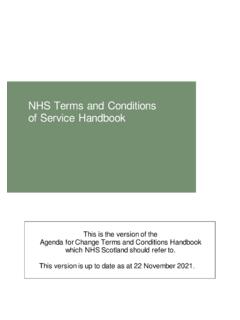Transcription of THE ADMINISTRATIVE PROCEDURE ACT: AN …
1 THE ADMINISTRATIVE PROCEDURE ACT: AN INTRODUCTION. Gillian Metzger, Columbia Law School1. The ADMINISTRATIVE PROCEDURE Act (APA) is the statutory constitution of ADMINISTRATIVE government. It sets out the default rules that govern how federal agencies act and how they can be challenged, and embodies important ADMINISTRATIVE law norms, such as procedural regularity and reasoned decision-making. This overview summarizes the historical and current context of the APA; the statute's key features, in particular its procedural requirements for agency action; and potential grounds for challenging agency action under the APA. 1. The APA: History and Current Context It is helpful to first understand the APA in its historical context, because there are disconcerting parallels to our contemporary situation. The APA was the end result of a highly political movement for ADMINISTRATIVE reform over the course of the New Deal. On one side was the private bar in the form of the American Bar Association, representing the interests of their business clients, attacking New Deal agencies for acting arbitrarily and wielding absolute power free from procedural or judicial constraints.
2 The National Labor Relations Board was a particular target. On the other side were FDR and the New Deal agencies, many recently created and granted broad power by Congress, insisting on the need for ADMINISTRATIVE authority and flexibility to deal effectively with the economic fallout from the Depression. A prime example of FDR's strong executive views was his proposed legislation consolidating regulation and budget powers under executive agencies, instead of independent agencies. This legislation also would have given the president extensive reorganization authority something that should sound familiar today. Initially, conservative and business forces brought constitutional challenges against New Deal measures and opposed FDR politically, as with the Liberty League. But as the Court started to uphold measures and FDR continued in power, the opposition turned to ADMINISTRATIVE reform. These reform measures, which came to be embodied in the Walter-Logan bill that passed both houses of Congress in 1940, were in reality about limiting ADMINISTRATIVE government, using the imposition of substantial procedural requirements across all agencies and expanded judicial review.
3 FDR vetoed the bill, having preemptively asked his attorney general to form a committee to research ADMINISTRATIVE PROCEDURE . That committee compiled detailed reports on how agencies 1. This document is based on a modified transcript of remarks delivered at an ADMINISTRATIVE PROCEDURE Act training hosted by the American Constitution Society, Brennan Center for Justice, Poverty & Race Research Action Council, and AARP Foundation, April 2017. Please contact with any questions regarding this document. 1. actually operated and ended up recommending against a single ADMINISTRATIVE code. Then World War II intervened. By the time Congress returned to the question, the existence of ADMINISTRATIVE government was no longer under threat, but there was also more public concern about controlling ADMINISTRATIVE power, and more support for a general code. That code, adopted in 1946, was the APA. The contemporary relevance of this background is that we are today seeing an attack on the ADMINISTRATIVE state of the level that occurred in 1930s.
4 Some of the fundamental constitutional challenges brought against ADMINISTRATIVE action such as attacks on ADMINISTRATIVE adjudication or legislative delegations as unconstitutional are surfacing again in the courts. We are also again seeing legislation that would significantly cut back on ADMINISTRATIVE governance. The Regulatory Accountability Act, which contains many recent proposals, passed the House. This is the contemporary equivalent of Walter-Logan it would impose extensive hearing and other obligations on agencies, particularly for big ticket rules. It also seeks to intensify judicial scrutiny of agency action, provides for congressional review of new regulations, and other measures. We also have President Trump's anti-regulatory Executive Orders, in particular Reducing Regulation and Controlling Costs ( two for one ),2 the Comprehensive Plan for Reorganizing the Executive Branch 3 and Enforcing the Regulatory Reform agenda , 4 which orders agencies to establish reform taskforces; his anti- ADMINISTRATIVE appointees; and his agency-slashing budget proposals.
5 We are at a moment where the fundamental structure of ADMINISTRATIVE governance is under attack, and there is a real question about the extent to which the regime enacted by the APA will continue. This also means that it is important for progressives to consider not only immediate actions to challenge new developments, but also what the impact may be on ADMINISTRATIVE power over the long term. 2. What are Key Features of the APA Regime? The APA contains two main sets of One set governs PROCEDURE , and the other set governs judicial review. 2. Available at: and-controlling. 3. Available at: reorganizing- comprehensive-plan-reorganizing-executiv e. 4. Available at: reform- agenda 5. Procedural and judicial review are what the APA is known for today. There were other important provisions in the APA as enacted: one was a precursor of the Freedom of Information Act (FOIA)requiring that agencies publish materials they rely on or that formulate policies; others created and protected ADMINISTRATIVE Law Judge (ALJ).
6 Independence. 2. i) Procedural requirements On the procedural front, the APA divides the world into rulemaking and adjudication. It does this definitionally, by providing that everything that isn't rulemaking is As a result, although the APA adopts a broad definition of rulemaking, the scope of what counts as adjudication is vast and highly varied. The APA's two procedural categories are further subdivided into formal and informal versions. That is, we have formal and informal rulemaking; and formal and informal adjudication. Each of these entails different procedural requirements under the terms of the APA. Notably, the APA functions to set defaults: it can be trumped by the substantive statute under which the agency is acting. Some substantive statutes, for instance, impose a hybrid form of rulemaking that combines informal rulemaking (described further below) with hearings. a) Formal rulemaking Formal rulemaking has been largely a dead letter since the 1960s, though one effect of the Regulatory Accountability Act would be to revive it.
7 Formal rulemaking essentially imposes an adjudicatory frame onto rulemaking, such that a rule must be based on evidence in the record, entailing findings and other trial-like procedures . This process is hugely resource This type of rulemaking currently is imposed only where required by other b) Informal ( notice and comment ) rulemaking; process for creating or revoking regulations, and exceptions Informal rulemaking is generally known as notice and comment rulemaking. This is the standard form of rulemaking today. For such rulemaking, agencies are required to publish an advance notice of proposed rulemaking that includes either the terms or substance of the proposed rule or a description of the subjects and issues involved, so that the public may is given an opportunity to participate in the rulemaking through submission of written data, views, or arguments. 9 Following formulation of the rule, there is also centralized regulatory review under OIRA and the White House (required by executive orders).
8 10. 6. The APA provides that adjudication means agency process for the formulation of an order, where an order . means the whole or a part of a final disposition of an agency in a matter other than rule making but including licensing. It defines rule making as agency process for formulating, amending, or repealing a rule and a rule . as the whole or a part of an agency statement of general or particular applicability and future effect designed to implement, interpret, or prescribe law or policy or describing the organization, PROCEDURE , or practice requirements of an 5 Code 551(5)-(7). See also Attorney General's Manual on the ADMINISTRATIVE PROCEDURE Act (1947) at 14-15. As discussed below, agencies may also issue or rescind memoranda or guidance that is not subject to the same procedural requirements as rulemaking. 7. 5 556-57. 8. 5 553(c). 9. 5 553 (b)-(c). 10. See, , Exec. Order No. 12,866 (1993). 3. Unless the substantive statute that authorizes the regulation provides otherwise, the APA.
9 Imposes the same procedural requirements on repeals of existing rules as adoption of new In order for the Trump administration to repeal an Obama administration rule that was promulgated using notice and comment, then, it must go through notice and comment On the other hand, the APA exempts some rules even from notice and comment procedures . 13. One ground for this is when there is good cause; another is where the agency is promulgating statements of policy, interpretive rules, or procedural Policy statements and interpretations are often referred to as guidance. Importantly, since guidance isn't subject to notice and comment requirements, it can be much more easily repealed as evident in the example of the transgender bathroom c) Formal adjudication Formal adjudication involves a hearing before an ADMINISTRATIVE law judge (ALJ), then an appeal, often to the agency head. This process is typical of independent regulatory agencies, such as the NLRB and SEC.
10 Formal adjudication applies only if the statute requires hearing and decision on the record. d) Informal adjudication Informal adjudication is, essentially, everything else. Here there is very little required only a brief explanation of the basis for denial. Substantive statutes, however, may impose additional procedural requirements. Agencies also have developed more elaborate procedures by regulation, and some additional procedures can be required by due process. ii) Judicial review The APA makes most final agency action judicially reviewable, with some limitations. One cannot challenge action made unreviewable by statute or committed to agency discretion, with certain categories of action that are presumptively unreviewable, such as individual enforcement 11. See Motor Vehicle Mfrs. Ass'n v. State Farm Mut. Auto. Ins.,463 29 (1983) (vacating the rescission of an air bags rule because the same process is required for rescinding regulations as for passing them).








